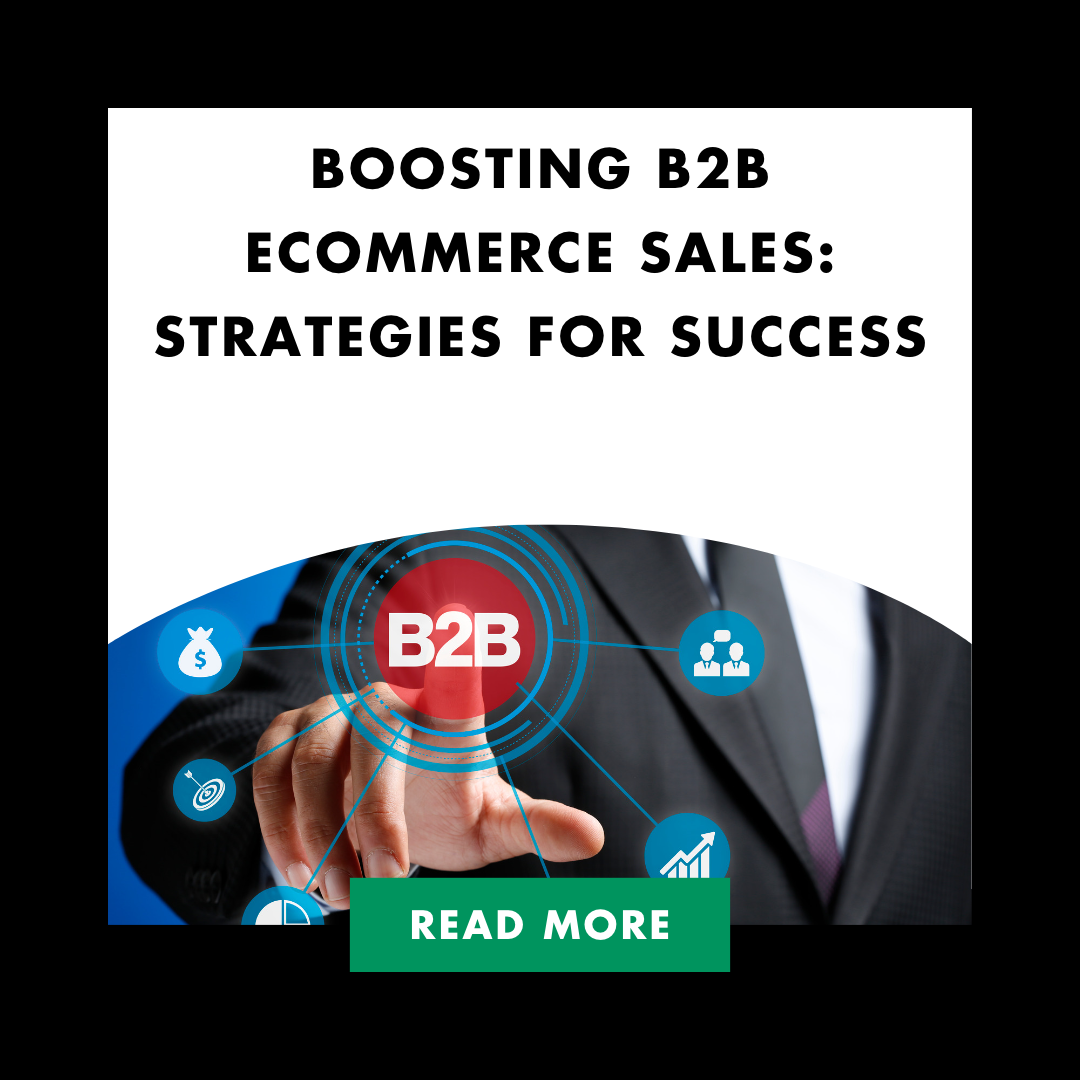Boosting B2B eCommerce Sales: Strategies for Success
As the B2B eCommerce realm continues to develop quickly, companies must remain abreast of emerging trends and advances in order to stay competitive. This blog post will delve into the key aspects shaping today’s B2B eCommerce landscape, providing valuable insights for business owners seeking to increase their sales and enhance customer experiences.
We’ll explore how technology is driving growth in this sector, with particular focus on targeting millennial buyers who are increasingly influencing purchasing decisions. Additionally, we’ll discuss the importance of developing a data-driven content marketing strategy that leverages customer insights for personalization and engagement.
Furthermore, you’ll learn about headless commerce architecture as an innovative approach to enhancing user experience across devices while ensuring mobile compatibility and compliance within your online marketplace. Stay tuned as we uncover actionable strategies for navigating these complex dynamics in B2B eCommerce.
Table of Contents
Understanding the B2B eCommerce Landscape
The emergence of tech has facilitated access to fresh markets and channels for B2B eCommerce, leading to a surge in its growth. Since 2023, e-commerce has become a key purchasing gateway for corporate buyers, with two-thirds of them intentionally opting for digital or remote in-person engagement when given a choice.
The impact of technology on B2B eCommerce growth
Technological advancements have played a significant role in driving the increase in B2B sales. From efficient inventory management systems to AI-powered chatbots assisting customers throughout their purchase journey, these innovations have helped streamline operations and improve customer experience. Additionally, online marketplaces like Amazon Business provide an accessible platform for business buyers to explore products from various suppliers at competitive prices.
Shifts in buyer preferences towards digital platforms
In recent years, there has been a noticeable shift in buyer preferences as more people opt for online shopping over traditional in-person sales methods. This trend is not only limited to consumers but also extends into the world of B2B commerce. According to Forbes, modern-day business buyers expect seamless experiences similar to those offered by popular consumer-facing platforms such as Amazon and eBay. As such, companies must adapt their strategies accordingly if they wish to stay competitive in this ever-evolving landscape.
Understanding the B2B eCommerce Landscape is a critical part of any business strategy, as technology and buyer preferences are rapidly changing. To capitalize on this shift in behavior, it’s important to target millennial buyers through effective strategies that engage decision-makers.
Targeting Millennial Buyers in B2B eCommerce
Millennial buyers make up 73 percent of today’s B2B purchasers; they conduct extensive research before making decisions and prefer platforms like Amazon Business that offer pricing selection convenience similar to Amazon itself. Catering specifically towards this demographic can prove beneficial for businesses looking forward.
Characteristics of Millennial Buyers
- Digital Natives: Millennials grew up with technology, so they are comfortable using digital tools and channels for communication, research, and purchasing.
- Socially Connected: This generation values peer recommendations and online reviews when evaluating products or services. Encourage satisfied customers to share their experiences on social media to increase your brand’s credibility among millennial business buyers.
- Educated Decision-Makers: Millennials tend to be well-informed about the latest eCommerce trends and expect a seamless user experience across devices. Make sure your website is mobile-friendly and offers easy navigation features.
Strategies for Engaging Millennial Decision-Makers
- Create Informative Content: Develop educational resources such as blog posts, whitepapers, or webinars that address common pain points faced by your target audience. This will help establish your company as an industry expert while providing valuable insights to potential clients. (source)
- Incorporate Personalization: Use customer data analysis techniques like segmentation or predictive analytics to tailor marketing messages based on individual preferences or behaviors. Personalized email campaigns have been shown to increase B2B sales by up to 20 percent.
By understanding the characteristics of millennial buyers and implementing strategies to engage them, businesses can effectively target this growing demographic in B2B eCommerce. Employing data-driven intelligence, businesses can craft a content marketing plan that caters to each customer’s distinct requirements.
Developing a Data-driven Content Marketing Strategy
To develop a successful content marketing strategy in B2B eCommerce, organizations need to prioritize critical capabilities while partnering closely with key distributors. One essential aspect is understanding the target audience through regular collection and analysis of customer data which can be used to personalize the buyer’s journey.
Importance of Data Collection and Analysis
B2B sales have become increasingly reliant on data-driven decision making to maximize success. By gathering data related to your customers, like demographic info, buying habits and browsing patterns, you can get a better understanding of their likes and needs. By leveraging customer information, such as demographic data, past purchases and web browsing activities, you can create content that is specific to your target market and encourages interaction on your digital platform.
Personalizing Content Based on Customer Insights
- Create tailored product recommendations: Use customer data to recommend products or services that are most likely to appeal to individual business buyers based on their previous purchases or browsing patterns.
- Segment email campaigns: Develop segmented email campaigns targeting specific groups within your audience by considering factors like industry type, company size, or geographic location. This approach allows for more personalized messaging that speaks directly to each segment’s unique pain points.
- Publish educational resources: Offer helpful resources such as blog posts or whitepapers addressing common challenges faced by your customers in order to provide solutions and position yourself as an expert within the industry.
Partnering with key distributors and leveraging customer data can help businesses stay ahead of eCommerce trends and increase B2B sales. By prioritizing inventory management and online marketplace capabilities, organizations can reduce their reliance on in-person sales and sales reps, while still providing a personalized experience for their customers.
Developing a data-driven content marketing strategy is essential to ensure that your eCommerce business remains competitive and successful. By leveraging headless commerce architecture, you can further enhance user experience and create seamless customer journeys across devices.
Enhancing User Experience Through Headless Commerce Architecture
Adopting headless commerce architecture allows B2B brands to separate their website’s front end from its back end, making it easier to lower budgets while maintaining an optimal user experience. This approach enables greater flexibility when implementing responsive mobile websites or introducing one-click checkout options for your online store.
Benefits of Headless Commerce Architecture
- Faster loading times: By decoupling the presentation layer from the backend, businesses can optimize site performance and deliver content more quickly, leading to improved customer satisfaction and increased sales.
- Better customization: With a headless setup, companies have more control over their website’s design and functionality without being constrained by traditional eCommerce platforms. This allows them to create unique experiences tailored specifically for their target audience.
- Easier integration with third-party tools: Since headless commerce separates frontend development from backend processes, it becomes simpler to integrate various marketing tools like email automation software or inventory management systems into your online marketplace.
Implementing Seamless User Experiences Across Devices
To ensure a consistent shopping experience across all devices – desktops, smartphones, tablets – businesses must prioritize responsive web design in their content marketing strategy. A study by Google found that users are five times more likely to abandon a task if the site isn’t optimized for mobile use (source). Therefore, investing in responsive design not only caters to modern buyers’ preferences but also helps increase B2B sales as customers find it easier to navigate through your platform regardless of device type. Incorporating elements such as single-tap checkout and straightforward navigation menus can further boost the user experience, leading to customer commitment and recurrent purchases.
By leveraging headless commerce architecture, businesses can ensure a seamless user experience across all devices. To further optimize the customer journey, it is essential to consider mobile compatibility and compliance when developing an eCommerce marketplace.
Ensuring Mobile Compatibility & Compliance in Your Marketplace
As more business transactions occur on mobile devices, ensuring mobile compatibility and compliance are crucial features of any successful B2B marketplace. Prioritizing these aspects in your content marketing strategy will help you cater to the growing number of buyers who prefer using their smartphones or tablets for purchasing decisions.
The Importance of Mobile-friendly Design
Creating a mobile-friendly design is essential for businesses aiming to maximize B2B sales in the digital age. A responsive website ensures that users can easily navigate through your online marketplace regardless of the device they’re using. Some key elements to consider when optimizing your site for mobile include:
- Responsive layouts that adapt to different screen sizes
- User-friendly navigation menus and buttons
- Faster page load times by compressing images and minimizing code bloat
- Avoiding excessive pop-ups or intrusive ads that may hinder user experience
Addressing Regulatory Requirements and Security Concerns
Beyond offering a seamless browsing experience, it’s important to address regulatory requirements and security concerns associated with eCommerce transactions. Ensuring compliance with industry standards like PCI DSS (Payment Card Industry Data Security Standard) not only protects sensitive customer data but also helps build trust among business buyers visiting your platform.
To maintain high levels of security, implement measures such as SSL certificates, secure payment gateways, and robust inventory management systems. Additionally, stay up-to-date on eCommerce trends related to data privacy regulations like GDPR and the California Consumer Privacy Act (CCPA) to ensure your marketplace remains compliant.
FAQs in Relation to B2B Ecommerce
The B2B (business-to-business) concept in e-commerce refers to transactions between businesses, where one company sells products or services to another. This differs from B2C (business-to-consumer), which involves selling directly to individual customers. Key aspects of B2B e-commerce include wholesale pricing, bulk orders, and customized solutions for clients.
B2B has significantly impacted e-commerce by driving technological advancements, streamlining supply chain processes, and increasing global trade opportunities. It has also led to a shift towards digital platforms as buyers prefer convenient online purchasing experiences. Additionally, it fosters innovation through competition among suppliers and encourages businesses to adopt data-driven strategies for improved customer targeting.
By 2023, global B2B eCommerce sales are expected to reach $20.9 trillion USD, accounting for approximately 17% of all worldwide retail sales. The growth will be driven by increased adoption of digital technologies across industries and regions as well as shifting buyer preferences towards more efficient online purchasing options.
There are four main types of Business-to-Business models: Product-based companies sell physical goods; Service-based companies offer specialized services; Software or SaaS (Software as a Service) providers deliver cloud-based solutions; and Marketplaces connect buyers with multiple suppliers, facilitating transactions between them.
Conclusion
In conclusion, B2B eCommerce is rapidly evolving and businesses need to adapt to stay competitive. Understanding the impact of technology on growth, targeting millennial buyers, developing a data-driven content marketing strategy, enhancing user experience through headless commerce architecture and ensuring mobile compatibility are all key factors in building a successful B2B eCommerce business.
At Project, we specialize in helping businesses navigate the complex world of B2B eCommerce. Reach out now to find out how our experience can help you reach your B2B eCommerce objectives.
Contact us today to take your B2B eCommerce business to the next level!
Want to Talk Strategy?
Is this something you're looking to dive deeper into? Sign up for a free strategy session with our team!
Let's TalkSubscribe for New Content
Share on Social
New Posts to Check Out

From Recruiter Posts to Revenue: Social Selling Playbook for BDMs

THC Beverages in a Pre-Ban Year: How to Maximize Revenue and De-Risk Your Brand


Wholesale/Trade Enablement: Sell-In Decks, One-Pagers & Sampling Plans

From Recruiter Posts to Revenue: Social Selling Playbook for BDMs

Creator & UGC Programs: What’s Actually Allowed and What Converts

Executive Social That Actually Drives Pipeline in 2026

First-Party Data Engine: Email/SMS Flows that Don’t Get You in Trouble

Winning Sales Strategy for 2026: SLAs, Lead Scoring & Shorter Cycles

